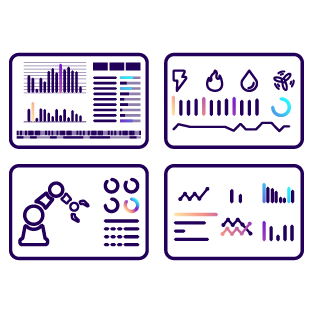Software
for Modern
Factories
We help factories in Digital Tranformation Production Optimisation Waste Reduction Paperless Manufacturing Energy Savings
ANT SMART FACTORY
One platform. Plenty of solutions for Manufacturing Operations Management
What We Do
ANT Solutions is a one-stop provider for your manufacturing improvement needs.

Machine
Connectivity
We collect signals from every possible machine on the market

Software
Development
You get an out-of-the-box modular system ready for major customization

Implementation
We provide the infrastructure and do all the heavy lifting

Continuous
Support
You get 24h/7 on demand support
Cloud Manufacturing
Unlock the Potential of Cloud Manufacturing: Increase Efficiency, Reduce Costs, and Enhance Product Quality. Choose between Cloud-Native and On-Premise Architecture
- Scalability
- Accessibility
- Agility and Flexibility
- Better Use of IT Resources
- Additional Cloud Services
- Improve Security
- High Availability
Continuous Improvement
Empower your solution with multiple extensions
Benefits for your production
65%
FASTER REACTION TIME
- • Real-time production data from machines
- • On-line notifications for production maintenance & quality
- • Production progress & quality online monitoring
90%
REDUCTION IN REPORTS GENERATION
- • Automatic data collection from the machines
- • Bi-directional interface with ERP
- • Digital guidance for Operators
15%
OEE INCREASE
- • Higher machines net run time
- • Microstops reduction
- • Less defects
Transform your production in 6 weeks!
We will implement the standard system in 6 weeks, thanks to out-of-the-box solution and proven implementation method

2023 Digitalisation Guide
- Learn what are the key steps to digitalise factory
- Identify key problems that occur during the production
- How software for factories fits industry 4.0 paradigms
- Why digitisation of production plants fails?
- What the MES price depends on?
- What human resources do I have to reallocate to the project?
Related articles

Manufacturing Data Collection – Connect Machines with Modern Production Software
In the evolving landscape of manufacturing, the integration of machine connectivity and modern production software stands as a cornerstone. It marks the confluence of real-time

MES audit – how to carry out pre-implementation phase?
The implementation of a MES system is a complex and costly process that requires careful planning and preparation. A key step is to conduct a

How to integrate MES with ERP system (SAP, Oracle, JDE, LN)?
Manufacturing Execution System (MES) and Enterprise Resource Planning (ERP) complement each other perfectly in production companies. However, these systems have different usage. ERP is mainly

Programma gestione produzione in fabbrica – Industria 4.0.?
Nell’era dell’Industria 4.0, le aziende stanno affrontando sfide sempre più complesse nella gestione della produzione. La necessità di integrare sistemi avanzati, come il software per

How does an MES system help meet the challenges facing the FMCG industry in 2023?
The FMCG industry faces new challenges every year. Production in line with government requirements and the need to meet the increasingly high expectations of end

What are the causes of micro-stoppages during the manufacturing process?
Learn about the common causes of micro-stoppages during the manufacturing process and how to address them to improve efficiency and productivity.










































